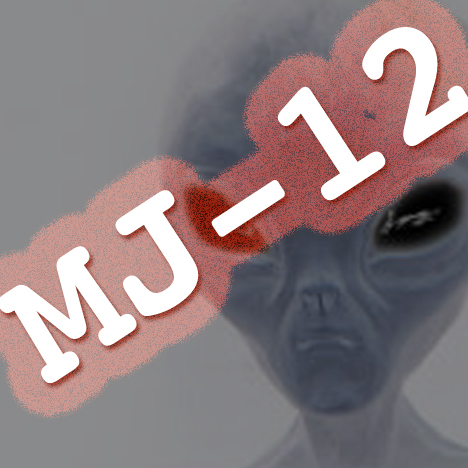 |
| MJ-12 |
The conviction that the U.S. government is perpetrating a massive cover-up of extraterrestrial visits to the planet has become the source of vicious battles over the validity of the so-called “MJ-12” documents.
In 1987, William Moore and Stanton Friedman, two prominent ufologists, along with Jamie Shandera, a television producer, claimed to have come into possession of an eight-page document classified “TOPIC SECRET/MAJIC-EYES ONLY.” The subtitle read “BRIEFING DOCUMENT: OPERATION MAJESTIC-12; PREPARED FOR PRESIDENT-ELECT DWIGHT D. EISENHOWER,” and was dated 18 November 1952. “Majestic–12” was later shortened to “MAJIC-12,” or merely “MJ-12.”
This document supposedly contained proof of a government program initiated by President Harry Truman and directed by twelve military, scientific, and intelligence community leaders to deal with the recovery of an alien spacecraft that wrecked near Roswell, New Mexico.
  |
Authorities supposedly discovered four dead aliens who had ejected from the craft before it crashed. Although the bodies were in a state of decomposition, enough remained to be preserved, collected, and taken to government laboratories for analysis and study.
Among the twelve members of MJ-12 were Vannevar Bush and James Forrestal, who died in May 1949 and whose vacancy was left unfilled. Forrestal supposedly was directed by Truman in May 1947 to “proceed with all due speed and caution.” A cover story was concocted by MJ-12 that attributed the Roswell debris to weather research balloons.
Authorities claimed that the recovered “aliens” did not originate on Earth, but could only speculate as to where they had come from. Writing on the wreckage supposedly was indecipherable, leading to a secret Air Force project, SIGN, to determine the craft’s purpose and mission. The MJ-12 documents also refer to a 6 December 1950 crash near El Indio, Texas, which had burned up during entry into the atmosphere or upon impact.
When Dwight Eisenhower was elected president in 1952, the story continues, he came into knowledge of MJ-12 and continued the high level of secrecy. He noted the implications for national security and maintained MJ-12 under close wraps to avoid a “public panic.”
Moore, Friedman, and Shandera became aware of the document when Shandera received a roll of film in December 1984 that contained images of the MJ-12 memo to Eisenhower. But skeptics pointed out a number of problems with the documents, and challenged their authenticity.
Debunker Philip Klass found numerous discrepancies that called into question the style of dating (i.e., “18 November, 1952” rather than either November 18, 1952, or 18 Nov. 1952, both of which were in common use, whereas the former was not). The type on the documents matched no typewriter in existence at the time, but did match a Smith-Corona made in 1963.
Most damning, though, UFO skeptic Philip Klass found an exact duplicate of the Truman signature in the Library of Congress and contended that the 1957 memo had forged Truman’s signature. But the documents were so realistic that even Defense Department agents assessed the MJ-12 items.
Moore, the mastermind behind the documents intrigue, claimed to have played along with government investigators to gain official information about UFOs. Some accuse him of perpetrating a hoax. Stanton Friedman, who broke with Moore over other issues, nevertheless continued to be involved in the MJ-12 debate by publishing Top Secret/MAJIC in 1996.
He concluded that the documents appeared to have been prepared by people inside government, but could not determine whether they were genuine or deliberate deceptions. Although he challenged some of Klass’s points used to discredit MJ-12, Friedman only managed to “prove” noncontroversial truisms, such as the fact that those men on the list would likely have been on such a list, if one existed.
More damaging to the documents’ veracity, however, was a 14 July 1954 government memo found by Moore and Shandera in the National Archives from the special assistant to the president, Robert Cutler, to General Nathan Twining, which is generally regarded as a forgery and a “plant.”
Despite Freedom of Information Act access, no one has produced any other documents specifically referring to either the existence of MJ-12 or alluding to any of their findings, save extremely oblique references that could apply to any program.
Making matters even more complicated was the convenience of how the documents appeared—dropped onto Shandera’s front porch in a plain brown bag at the very time he was working with Moore on a UFO documentary. The further good fortune of the researchers, in that all the MJ-12 documents confirmed exactly what Moore had already written, caused even UFO conspiracy theorists to look with disbelief upon the serendipitous delivery.
Another convenient fact was that every man named in the MJ-12 list was dead when the documents mysteriously appeared, and thus they were unable to confirm the veracity of the list or the group’s mission.
As charges and countercharges flew, almost every person involved in the debate was accused of being a CIA “plant” or government “stooge.” Moore himself was viewed as spreading disinformation through forged documents so as to discredit “the movement.” On the other hand, Klass and others were lambasted as government fronts.